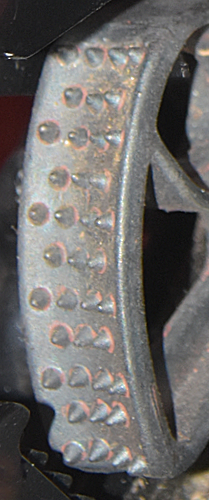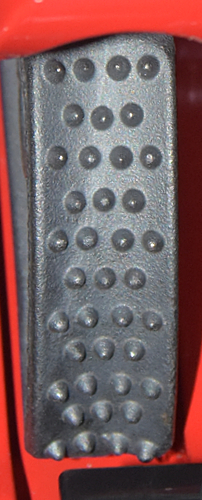Overview
[ Top
| Version B
| Return to Foot Ascenders
]
Version A
(#217)
Technical Details
 I acquired this Buckingham Mar-Bar from Tetyana Zurigat in 2007.
I acquired this Buckingham Mar-Bar from Tetyana Zurigat in 2007.
This version is 193 mm. tall, 320 mm. wide, 78 mm. thick, and weighs 1071 g.
The Buckingham Mar-Bar starts with a pair of large
CMI UltrAscenders (my Version C). A 300 mm. rod goes
through the bottom rear attachment holes, and a 140 mm. rod
passes through the top holes. A 150 mm. piece of flexible
tubing forms the left side of the rig (right side in the photo),
and a shorter piece stiffens the opposite side, above the buckle.
A piece of 25 mm. chain-stitched webbing starts at a sewn
in buckle on the left, passes through a rubber ring and then through
a 145 mm. long piece of 32 mm., 4.7 mm. wall PVC
tubing and over the lower rod, through the ascender holes and
another piece of PVC tubing, over the right side flex tubing,
over the upper rod and through the upper ascender holes, and then
down over the final flex tubing piece to the buckle. Finally,
two more pieces of coarse webbing cover the upper horizontal section
of the webbing frame.
The Mar-Bar (short for Jumar-Bar) was first conceived as part
of the Inchworm climbing system, an interesting historical innovation
that allowed for relatively efficient, hands-free, sit-stand climbing,
even for unskilled climbers. Cavers invariably used it as a single rope technique, so doubled ascenders were not necessary. The system all but disappeared from
caving scenes in the 1970s, so it is interesting to see the Mar-Bar
idea revived by arborists, even if they do not use it in an inchworm
system.
[ Top
| Version A
| Version C
| Return to Foot Ascenders
]
Version B
(#2287)
Technical Details
 I acquired this Buckingham Mar-Bar in 2017 as part of Bob Thrun’s collection.
I acquired this Buckingham Mar-Bar in 2017 as part of Bob Thrun’s collection.
This version is 193 mm. tall, 320 mm. wide, 78 mm. thick, and weighs 1071 g.
The foot rod on Version B goes through the lower front holes of the ascenders as opposed to the rear holes on Version A.
Putting the foot rod through the front holes brings the rope closer to the body. This is desirable, provided the rope does not drag, and that depends on where the climber places their feet. Of course, the climber should place their feet as far back as possible without having the rope drag. I doubt that many people would notice the difference climbing with Version B versus Version A.
[ Top
| Version A
| Version B
| Return to Foot Ascenders
]
Version C
(#2288)
Technical Details
 I acquired this Buckingham Mar-Bar as part of Bob Thrun’s collection.
I acquired this Buckingham Mar-Bar as part of Bob Thrun’s collection.
This Mar-Bar is 192 mm. tall, 327 mm. wide, 77 mm. thick, and weighs 1018 g.
Aside from the color of the ascenders and webbing, the only difference between this version and Version B is that the top of the ascenders on this version are drilled and bolted together with a #10-24 Machine screw and hex nut.
The machine screw was probably added by a prior owner. I don't see that the machine screw makes much difference.
[ Top
| Version A
| Version B
| Version C
]


